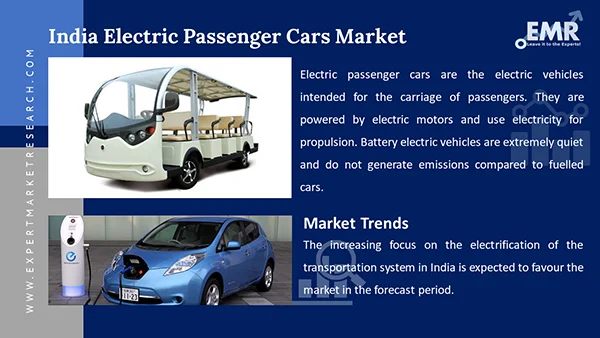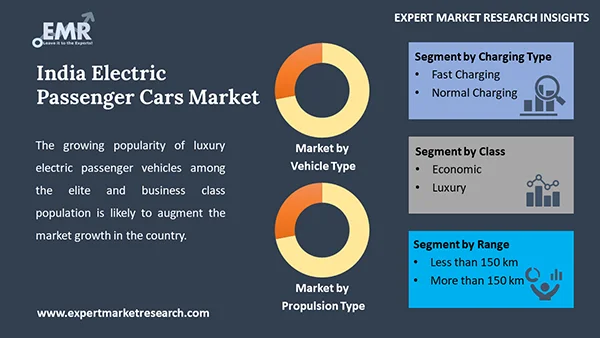
Consumer Insights
Uncover trends and behaviors shaping consumer choices today
Procurement Insights
Optimize your sourcing strategy with key market data
Industry Stats
Stay ahead with the latest trends and market analysis.
The India electric passenger cars market stood at a value of around USD 559.21 Million in 2025. The market is further expected to grow in the forecast period of 2026-2035 at a CAGR of 60.60% to reach USD 63830.81 Million by 2035.
Base Year
Historical Period
Forecast Period
Compound Annual Growth Rate
60.6%
Value in USD Million
2026-2035
*this image is indicative*
Battery electric vehicles are extremely quiet and do not generate emissions compared to fuelled cars. The stringent government regulations against carbon emissions are likely to be a major factor driving the segment growth. In addition to this, BEVs are gearbox free, less complex to drive, and tax efficient. Also, the maintenance cost of this type is comparatively low. Therefore, the middle-class population, which aims towards achieving cost savings on vehicles every month is likely to generate a significant demand for battery electric vehicles in the forecast period. Moreover, battery electric vehicles possess fewer moving parts than conventional petrol/diesel cars, and the servicing of BEVs is less cumbersome.

Read more about this report - REQUEST FREE SAMPLE COPY IN PDF
In India, the favourable government regulations to support the adoption of electric vehicles are significantly driving the growth of the market. The increasing focus on the electrification of the transportation system in India is expected to favour the market in the forecast period.

Read more about this report - REQUEST FREE SAMPLE COPY IN PDF
Electric passenger cars are the electric vehicles intended for the carriage of passengers. They are powered by electric motors and use electricity for propulsion. Furthermore, these vehicles can be charged using an EV charger at home, or at the electric vehicle charging station, or even on the move.
Based on propulsion type, the market can be segmented into:
On the basis of charging type, the market has been bifurcated into:
The market can be bifurcated based on class into:
By range, the market has been divided into:
The major vehicle types included in the market are as follows:
The rising demand for electric vehicles owing to the rising disposable incomes, increasing living standards, and rising concerns pertaining to the degradation of environment due to the greenhouse gas emissions are likely to be the key driving factors for the market. The growing popularity of luxury electric passenger vehicles among the elite and business class population is likely to augment the market growth in the country. Additionally, the growing penetration of electric vehicle manufacturing brands, such as Mercedes-Benz, Jaguar, Audi, BMW, Tata, Mahindra, and Kia Motors, among others in India is anticipated to invigorate the market in the forecast period. Moreover, the rising prices of fuel in the country is leading to a significant shift towards electric powered vehicles among the working-class. This factor will provide a further impetus to the market.
The report gives a detailed analysis of the following key players in the India electric passenger cars market, covering their competitive landscape, capacity, and latest developments like mergers, acquisitions, and investments, expansions of capacity, and plant turnarounds:
The comprehensive EMR report provides an in-depth assessment of the market based on the Porter's five forces model along with giving a SWOT analysis.




*While we strive to always give you current and accurate information, the numbers depicted on the website are indicative and may differ from the actual numbers in the main report. At Expert Market Research, we aim to bring you the latest insights and trends in the market. Using our analyses and forecasts, stakeholders can understand the market dynamics, navigate challenges, and capitalize on opportunities to make data-driven strategic decisions.*
Get in touch with us for a customized solution tailored to your unique requirements and save upto 35%!
In 2025, the India electric passenger cars market attained a value of USD 559.21 Million.
The market is estimated to grow at a CAGR of 60.60% between 2026 and 2035.
The market is estimated to witness a healthy growth in the forecast period of 2026-2035 to reach USD 63830.81 Million by 2035.
The major drivers of the market include the rising demand for electric vehicles, growing popularity of luxury electric vehicles among the elite class, stringent government regulations against the emission of greenhouse gases from cars, and rapid urbanisation.
The shift towards electric vehicles from traditional fuel-based vehicles owing to the growing efforts to curb pollution is expected to be a key trend guiding the growth of the industry.
Battery electric vehicles (BEV), plug-in hybrid electric vehicles (PHEV), and hybrid electric vehicles (HEV) are the different segments based on the propulsion type.
Fast charging and normal charging are the different segments on the basis of charger type.
Economic and luxury are the different classes considered within the market report.
Less than 150 km and more than 150 km are the different product range explored in the market report.
Hatchback, sedan, and SUV and MPV are the major vehicle types mentioned in the market report.
The major players in the industry are Tata Motors Limited, Mahindra Electric Mobility Limited, MG Motor India Pvt. Ltd, Hyundai Motor India, Kia India Pvt Ltd., Maruti Suzuki India Limited, Audi India Pvt Ltd., and BMW India, among others.
Explore our key highlights of the report and gain a concise overview of key findings, trends, and actionable insights that will empower your strategic decisions.
| REPORT FEATURES | DETAILS |
| Base Year | 2025 |
| Historical Period | 2019-2025 |
| Forecast Period | 2026-2035 |
| Scope of the Report |
Historical and Forecast Trends, Industry Drivers and Constraints, Historical and Forecast Market Analysis by Segment:
|
| Breakup by Propulsion Type |
|
| Breakup by Charging Type |
|
| Breakup by Class |
|
| Breakup by Range |
|
| Breakup by Vehicle Type |
|
| Market Dynamics |
|
| Competitive Landscape |
|
| Companies Covered |
|
| Report Price and Purchase Option | Explore our purchase options that are best suited to your resources and industry needs. |
| Delivery Format | Delivered as an attached PDF and Excel through email, with an option of receiving an editable PPT, according to the purchase option. |
Single User License
One User
USD 3,999
USD 3,599
tax inclusive*
Datasheet
One User
USD 2,499
USD 2,249
tax inclusive*
Five User License
Five User
USD 4,999
USD 4,249
tax inclusive*
Corporate License
Unlimited Users
USD 5,999
USD 5,099
tax inclusive*
*Please note that the prices mentioned below are starting prices for each bundle type. Kindly contact our team for further details.*
Flash Bundle
Small Business Bundle
Growth Bundle
Enterprise Bundle
*Please note that the prices mentioned below are starting prices for each bundle type. Kindly contact our team for further details.*
Flash Bundle
Number of Reports: 3
20%
tax inclusive*
Small Business Bundle
Number of Reports: 5
25%
tax inclusive*
Growth Bundle
Number of Reports: 8
30%
tax inclusive*
Enterprise Bundle
Number of Reports: 10
35%
tax inclusive*
How To Order

Select License Type
Choose the right license for your needs and access rights.

Click on ‘Buy Now’
Add the report to your cart with one click and proceed to register.

Select Mode of Payment
Choose a payment option for a secure checkout. You will be redirected accordingly.
Gain insights to stay ahead and seize opportunities.

Get insights & trends for a competitive edge.

Track prices with detailed trend reports.

Analyse trade data for supply chain insights.

Leverage cost reports for smart savings

Enhance supply chain with partnerships.

Connect For More Information
Our expert team of analysts will offer full support and resolve any queries regarding the report, before and after the purchase.
Our expert team of analysts will offer full support and resolve any queries regarding the report, before and after the purchase.
We employ meticulous research methods, blending advanced analytics and expert insights to deliver accurate, actionable industry intelligence, staying ahead of competitors.
Our skilled analysts offer unparalleled competitive advantage with detailed insights on current and emerging markets, ensuring your strategic edge.
We offer an in-depth yet simplified presentation of industry insights and analysis to meet your specific requirements effectively.
Share